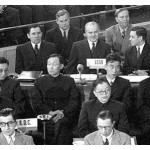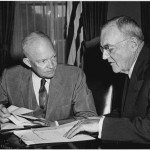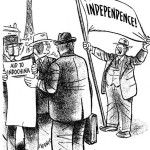
In April 1954 diplomats from several nations – including the United States, the Soviet Union, China, France and Great Britain – attended a conference in Geneva, Switzerland. The Geneva gathering was convened to discuss two Cold War hotspots, Berlin and Korea – but by the time it began the Viet Minh had overrun the French base at Dien Bien Phu, forcing Vietnam onto the agenda. By the start of May, Paris had announced its intention to withdraw from Indochina and dismantle the colonial administration there. The French withdrawal would leave Vietnam without an established national government, placing it at risk of a communist takeover. The Geneva conference was given the unenviable task of arranging for Vietnam’s reunification and self-government. The conference produced a set of resolutions known as the Geneva Accords, a roadmap for Vietnam’s transition to independence. The Accords were not supported by major players, however, so had little chance of success.
The delegates at Geneva noted similarities between Vietnam and post-war Korea, a country also left divided after World War II. Until 1945 Korea had been occupied by the Japanese. After their withdrawal, the Korean peninsula was divided at the 38th parallel. This division was intended to be temporary, however, the region soon firmed into two separate states: communist-controlled North Korea, backed by the Soviet Union and China; and South Korea, backed by the United States and its Western allies. The rulers of both states thought themselves the rightful rulers of the entire peninsula. In 1950 North Korean troops launched an invasion of the South, triggering an international response. A United Nations military coalition led by the United States intervened to prevent South Korea from being overrun. A ceasefire ended the Korean War in July 1953 with the peninsula still divided.

The Geneva conference adopted a similar approach in Vietnam. Vietnamese territory would be divided temporarily into north and south, then given a roadmap to free elections, self-government, reunification and independence. But the plan hatched at Geneva was undermined and sabotaged by a lack of support. American delegates attended the Geneva summit but scarcely participated. US Secretary of State John Foster Dulles, a vehement anti-communist, refused to recognise, shake hands with or speak directly to Chinese or Viet Minh delegates. There was also division and disagreement in the communist bloc. Both China and the Soviet Union, for their own strategic reasons, refused to back the Viet Minh claim to govern all of Vietnam. Ho Chi Minh’s chief negotiator, Pham Van Dong, chose not to align too closely with Moscow or Beijing, preferring that North Vietnam remain in charge of its own destiny. British delegate Sir Anthony Eden later remarked that he had “never known a conference of this kind… the parties would not make direct contact and we were in constant danger of one or another backing out the door”.
The Geneva conference took until July 21st before it produced a formal agreement. Among the terms of the Geneva Accords were the following:
- Vietnam would become an independent nation, formally ending 75 years of French colonialism. The former French colonies Cambodia and Laos would also be given their independence.
- Vietnam would be temporarily divided for a period of two years. The temporary border was fixed at the line of latitude 17 degrees north of the equator, also known as the 17th parallel. The border was intended to “settle military questions with a view to ending hostilities … the military demarcation line is provisional and should not in any way be interpreted as constituting a political or territorial boundary”.
- Nationwide elections were scheduled for July 1956. They would be conducted under international supervision. The election result would determine the political system and government in the newly independent Vietnam.
- During the two year transition period, military personnel were instructed to return to their place of origin: Viet Minh soldiers and guerrillas to North Vietnam, French and pro-French troops to South Vietnam. Vietnamese civilians were free to relocate to either North or South Vietnam.
- During the transition period both North and South Vietnam agreed not to form any foreign military alliances or authorise the construction of foreign military bases.

On the surface, the Geneva Accords appeared a sensible solution to a difficult problem. The Accords generated some optimistic press coverage and hope that Vietnam could be stabilised and eased into independence. In reality, the Accords were almost certainly doomed to fail. They were hastily drafted and rushed into existence barely two months after the fall of Dien Bien Phu. The Geneva conference was an acrimonious affair, undermined by Cold War tensions and mistrust. The Accords were not negotiated in good faith: many stakeholders either refused to sign or signed under pressure. Both South Vietnam and its main benefactor, the United States, “acknowledged” the Accords but refused to sign them or commit to honouring their terms. The Viet Minh delegates did not wish to sign: they sceptical about the scheduled 1956 elections and reluctant to agree to the 17th parallel border, which would mean surrendering territory to the South. In the end, the Viet Minh representatives signed on the instructions of Ho Chi Minh, who was himself under pressure from the Soviet Union and China.
“That the end envisioned by the 1954 accords (peace) proved elusive was not due to the means by which peace was to be attained. The fatal defect was to be found in the fact that the accords were not confirmed or assented to by all of the parties to the conflict. The US and the South are not bound by the accords, since they not only refused to sign… or endorse orally the declaration, but also stated affirmatively their opposition.”
Roger H. Hull, US lawyer
The Geneva Accords also provided a 300 day grace period, so that civilians could relocate to North or South Vietnam. The United States began providing assistance to those Vietnamese who wanted to move south. A joint US-French naval task force was assembled near Haiphong harbour, while US personnel and aid workers organised refugee camps, food and medical supplies in South Vietnam. This process – pointedly titled Operation Passage to Freedom – was part humanitarian mission, part propaganda ploy. American politicians described it as the generous act of a benevolent superpower, fulfilling its moral obligation to help freedom loving people. Approximately 660,000 Vietnamese chose to relocate from North Vietnam to the South; almost half of them did so aboard American ships. Many southbound refugees were frightened by rumours that the North intended to slaughter Catholics. Around 140,000 Vietnamese also moved in the opposite direction, south to north, with little or no assistance.

1. The Geneva Accords refer to series of agreements pertaining to the future of Vietnam. They were produced during multilateral discussions in Geneva between March and July 1954.
2. The discussions at Geneva were marred by Cold War paranoia and mistrust. Delegates from some nations refused to negotiate directly, while the United States and South Vietnam refused to sign the Accords.
3. Under the terms of the Geneva Accords, Vietnam was divided at the 17th parallel for a period of two years. Free elections were scheduled for July 1956 to decide the government of reunified Vietnam.
4. Both soldiers and militia from North and South Vietnam were instructed to return to their place of origin, while Vietnamese civilians were free to relocate to the north or south.
5. In 1954-55 the United States launched Operation Passage to Freedom to assist Vietnamese civilians with relocating from north to south. It was a humanitarian mission but also served as propaganda.
© Alpha History 2016. Content on this page may not be republished or distributed without permission. For more information please refer to our Terms of Use.
This page was written by Jennifer Llewellyn, Jim Southey and Steve Thompson. To reference this page, use the following citation:
J. Llewellyn et al, “The Geneva Accords of 1954”, Alpha History, accessed [today’s date], https://alphahistory.com/vietnamwar/geneva-accords-of-1954/.
